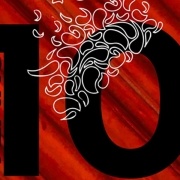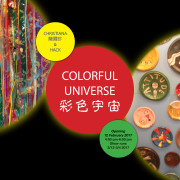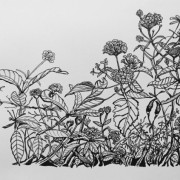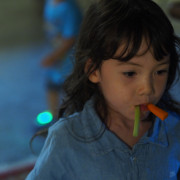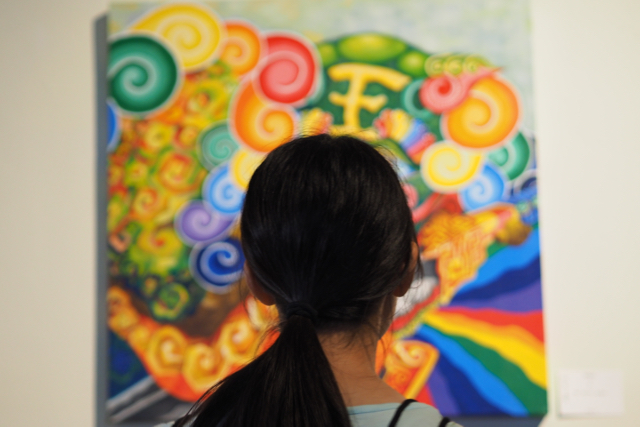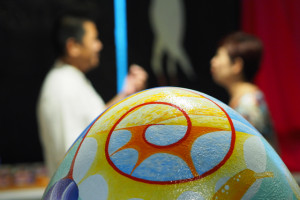Posts
12 February 2017, Visual Dialogues XV Colourful Universe 彩色宇宙
Visual Dialogues XV Colourful Universe 彩色宇宙Sunday February 12 at 4 PM – 6 Pm
https://www.facebook.com/events/256027314810845/
“Colorful Universe” showcases vibrant and mesmerizing visual pieces from Christiana Chien, in her debut art exhibition. Joining her is veteran artist Odd Hackwelder, also known as Hack who has had over 20 art exhibitions. Hack is known for being extremely prolific and for creating diverse series of work with the common bond of strong color and theme.
What brings them together is a mutual passion for creation, adventure, colors, perspectives, and a deep, true love for the universe.
Creation is never just solely a result from the artist’s own mind, but a true choreography and collaboration between the artist’s mind and all the elements under the laws and forces of the universe (light, gravity, velocity, reflection).
We hope that through our work, you’ll be able to see, think, and feel those elements at dance.
「彩色宇宙」展現了Christiana Chien(簡國珍)色彩斑斕絢麗的視覺作品。這也是她的初展。與她一同展出的是已有20場以上展出經驗的老手藝術家Odd Hackwelder(別名Hack)。Hack以旺盛的創造力名聞畫壇;連結其不同系列作品的重要關鍵為其鮮明的色彩和強烈的主題性。
———————–
Visual Dialogues 藝術對畫
between people, spaces and ideas
Two artists from different cultures with be featured in a monthly art show at the Red Room International Village, opening on the first Sunday of each month.
紅房會邀請兩位分別來自西洋及東方的藝術家來展出他們的作品,讓藝術氣息繚繞在紅房國際村的樑柱之間。
在每月的第一個週日,邀請您們一同享受創意與空間的對談。
20 March 2016, Solo Show by Julia Kao
 – Boundaries –
– Boundaries –
An expression by Julia Kao
A cheeky exploration of our daily interactions through installation and sculpture to illuminate the boundaries we often forget to draw, need to set, and are constantly at odds with. The exhibit hopes to empower viewers to take ownership of their right to filter what enters their lives, and reject what doesn’t sustain them. By doing so, we are better able to create a reality closer to our personal ideals.
| Solo Show |
– Installation – Sculpture – Photography – Collage –
Opening Reception:
3.20.2016 | 3PM – 7PM |
Gallery Hours:
Tues. Thurs. Sat. Sun | 3PM – 7PM |
@ Red Room
TAF Library 2F No. 177, Sec. 1, Jianguo S. Road, Taipei
空軍總部 「圖書館」2F 台北市大安區建國南路一段177號
www.redroomtaipei.com
Visual Dialogues III, December 2015
It was a Sunday, slightly rainy and drizzly but nothing too out of character for Taipei. Walking through the Taiwan Air Force base to the Red Room always filled me with a sense of electricity. I hope I’m not late and I can’t wait to get there.
Making my way up the stone stairs surrounded by the white walls, I see photos. I would stop and admire them but I’m being dragged inside by my need to see the space and what’s been done to it this month.
I open the door and am met with an energy that is new. There are photos that capture times that I have not yet experienced and places foreign to me. Arranged in a manner that are at once calculated yet relaxed. Marveling at the subject matter and some of the artistic style of the photographer I wander into the main part of the room when I see them.
The umbrellas, not strewn across the floor or laid in a nice pile by the entrance, but hung as if though they were red lanterns at a night market in Taipei. All with different designs and markings. They were the production of another artist. Both artists had come together to use the space to present their creativity and I was brought to smiles when I saw what they had done.
The space had an energy that was interjected by the art chosen by these two creative beings. A beautiful photo of the Taipei cityscape hung in the corner surrounded by photos just as entrancing. Renderings of the artist perspective of Taipei turned into quirky comic books sat as a welcome to guests of this event.
Voices hummed and people were nibbling on some food provided by Sababa. But everything quieted down as the artist took their place in the front of the room to talk about their process. Both Alex and Bara had complimentary vibrations. They smiled and joked about their process but you could see that they took their craft seriously. Yet in the space you could see that the ego was not such a big part of the process.
Sharing and letting the world experience what you have seen or your perspective seemed to be the ultimate goal for this visual dialogue. Two artists, one that realized the beauty in the world with his camera and the other that created her own with a paints, pens and tools… Couldn’t think of a better way to spend a Sunday.
Meet the artist: Interview with Ted Pigott
Photos from Ted’s current exhibition at the Red Room
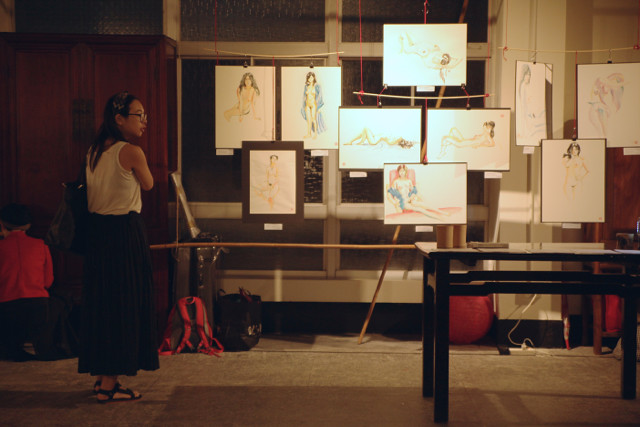
I burst through the doors of The Toasteria, out of breath and late. As I approached the stairs a man in black appeared. “Are you looking for Ted? He’s upstairs,” he said gesturing past staggered rows of drawings. Ted Pigott had been drawing over his lunchbreak at the Toasteria for a year when the owner of the restaurant asked him to display his drawings of the scenery and the food. The drawings in question featured a variety of styles from point work, to watercolor, black and white ink sketches, to colored pencil. Each drawing was encompassed by a simple, matte black frame. Though the frame stands out from the white walls of the Toasteria, it doesn’t dominate the space nor does it obscure the art. Like the artist, it eschews ostentation and exhibits a genuine, relaxed feel.
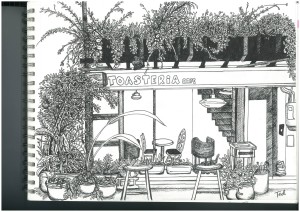 While some artists may define their main inspiration as another artist or as a lofty philosophy about what art should be, Ted’s philosophy is often delivered through a series of simple mantras: Draw what you see. Share what you draw. Every day is better when you draw. As long as he has his pen and pad of paper, he’s happy. In fact, his Facebook, which is covered with portraits of strangers, flowers, scenery, food, is a testament to his philosophy.
While some artists may define their main inspiration as another artist or as a lofty philosophy about what art should be, Ted’s philosophy is often delivered through a series of simple mantras: Draw what you see. Share what you draw. Every day is better when you draw. As long as he has his pen and pad of paper, he’s happy. In fact, his Facebook, which is covered with portraits of strangers, flowers, scenery, food, is a testament to his philosophy.
As I opened up the menu, Ted leaned over to recommend the three cheese omelet. “It’s my favorite. That’s why I drew it twice.” He chuckled. Sure enough, the wall behind us featured two omelets: one in color, the other in black and white. I looked back at the drawings for a moment. “Did you ever envision, when you were young, that this would be your life?” I asked him. He confessed he hadn’t. In fact, he hadn’t drawn for over two decades when he picked up his pen again in 2014.
It all started with a single line drawn over his lunchbreak. He had a sketchbook and, as the server placed a coffee mug in front of him, he decided to pick up his pen and try to draw it. “It probably wasn’t that good,” he told me. “But at least I did something that day for myself.” What began as a hobby soon became his full time job when he began sharing his work on Facebook. He speaks highly of the internet which has allowed him to share his art and aided his getting noticed by the Toasteria and the Red Room.
He has since largely overcome the fear and excuses he made for himself before that year. When I asked how an artist might overcome such a fear he replied “It doesn’t have to be perfect. Just get it on paper. Draw that first line.” After that, it’s just honing your craft. Throughout the video he maintained that anyone could become an artist if they wanted it enough. The way to do so is simple: Do what you love, love what you do, the rest comes from diligent practice of your craft.
Perhaps most important to Ted is his passion and his independence. He espouses the importance of following your own perspective and maintaining your own artistic integrity. He claims the internet is a large part of what has allowed him to sustain that independence. “The world is my studio, the internet my gallery,” he told me toward the end of the interview. With a sketchbook and a pen he’s happy wherever he goes, as long as he can draw what he’s passionate about.
If you’re looking to speak with Ted about his art, you might find him at a Red Room event, with his notebook and pens out. His drawings of the Red Room community, as well as other things he likes, are currently featured at the Red Room for the month of November. If you’d like to view Ted Pigott’s art, you can visit the Red Room where his art will be displayed next to JJ Chen’s for Red Room’s second installment in the Visual Dialogues series. You can also hear more about their art and their involvement with the Red Room at their Visual Dialogue Vernissage on November 18th.
You can read the full interview below or visit Ted’s Facebook page to see more of his art.
Did you ever envision, when you were young, that this would be your life?
No, I never did. That’s why I stopped drawing for twenty some years. I was working full time as a consultant nearby here, so I was traveling around and very busy, but then one day I thought “Hey I need to do something for me.” Before I’d work at my desk; I’d have meetings; I’d read Bloomberg business week. I thought I needed a bit of a change. So, number one, I thought I had to get out of the office. I thought I’m going to walk around and see the neighborhoods. Number two, I wanted to find good food and a good place to sit for the full hour—not like a dumpling place, not a noodle shop, not like a café. And the third thing was I wanted to do something I wanted to do. [I didn’t want to] read work e-mails, or do copy writing.
So I had a sketchbook and I decided that “hey, maybe I should try to draw this coffee cup”. So I just tried to draw it, and it probably wasn’t that good. Then my food came so I closed the book and I ate. It probably wasn’t that good but at least I did something that day for myself. You spend so much time doing things for somebody else that it’s rare you find time to do something for yourself. Anyone can do it. You can work on a play. You can draw. You can do whatever, but you can take that one hour and give it to yourself. [You should] not just sit and watch the news, or trying to get ahead of work. It’s up to each person.
When did you start deciding you wanted to exhibit your work? It seems like something that started to decompress, something to do for you. When did it become something more than that?
 Well, I started sharing my work on Facebook. Share your work. That’s another philosophy of mine. Social media is the best way to do that. Before all my stuff would just be in my sketchbook and you would never see it. You might see it and think “Oh, he’s got a sketchbook.” But you would never see it unless I showed it to you. Now if you like my page, if you are my friend on Facebook you know I draw a lot. It’s a great way to share. Also, if I show you my sketchbook now you might feel, out of politeness, “Oh, that’s good” or they don’t know what to say but they see it on Facebook by themselves, they might think “Hey I’ll give it a like”. I think the internet to day is very visual. If you write a story, a fictional story, not a lot of people are going to read it. They might think: I’m not going to read this, it’s too long, but a picture of flowers? ‘Like’. I like that. So it might make someone’s day a little better.
Well, I started sharing my work on Facebook. Share your work. That’s another philosophy of mine. Social media is the best way to do that. Before all my stuff would just be in my sketchbook and you would never see it. You might see it and think “Oh, he’s got a sketchbook.” But you would never see it unless I showed it to you. Now if you like my page, if you are my friend on Facebook you know I draw a lot. It’s a great way to share. Also, if I show you my sketchbook now you might feel, out of politeness, “Oh, that’s good” or they don’t know what to say but they see it on Facebook by themselves, they might think “Hey I’ll give it a like”. I think the internet to day is very visual. If you write a story, a fictional story, not a lot of people are going to read it. They might think: I’m not going to read this, it’s too long, but a picture of flowers? ‘Like’. I like that. So it might make someone’s day a little better.
It connects with people a little quicker than written word? It’s more accessible?
I think so. I think because it’s so visual and it’s a picture. It’s not a photograph, it’s different. You’ve taken some time to draw something so it has a more personal feel to it. You draw something and people like to look at it. [Photographs are still useful though—especially with camera phones.] Before I had to scan it, but phones are so good I can just take pictures of my drawing and upload them. That’s how you share you work and [phones] are a very valuable tool to help you share.
Another mantra is “Draw what you see”. Do you mean that literally? Do you feel there’s so much to see that it’s better to render ‘real life’?
That can be taken quite a few ways. That could be taken literally, or it could be like what you draw what you imagine. Draw what you see. The first part of the mantra is just draw. Every day you gotta draw –draw, draw, draw. Then what you see is the things that you, as an individual, see. I see these flowers, probably in a different way than you see these flowers. I gotta draw what I see. It can be imaginary, I’m not saying everything’s gotta be realistic but it has to be from your perspective. My perspective is probably different than yours.
[Your perspective is different] in more ways than one.
Yeah, exactly, the things I see are different. You live in Zhongli and I live in Taipei. I’m a man and you’re a woman. I see things differently than you. I’m interested in these flowers, MRT, beer, what I see what I ride around in Taipei.
I don’t draw a lot of temples. I don’t go to a lot of temples [because] that’s not what I see. You have to draw your passion. That’s another one of my mantras: Draw what you love, love what you draw. You gotta love what you draw. You have to draw what makes you excited. This [three cheese omelet] I like a lot. Beer, I like a lot. Pizza. These are things I like. These are things that make me excited, make me want to share. I’m not forced to draw something.
You don’t force yourself to draw things you aren’t inspired by.
Yeah. I think it’s possible to draw things you aren’t inspired by but I don’t think it has that same feel or magic. That’s what an illustrator has to do. They have to draw pieces they don’t want to draw. I’m not interested in technically possible. I think something that really moves people has to come from a place of passion.
When you first started you said your drawings probably weren’t that good. I feel a lot of people, especially beginners, they tend not to get past that stage, the ‘It’s not good stage’. How were you able to push past that? Were you able to do it because you told yourself it should be about you, about relaxing and de-stressing? How did you get yourself in the mindset to continue drawing? Then, when you decided to pursue it in a more serious way, that is, in a way that would allow for exhibitions, how did you transition from it being more personal, and private to public? Did you change your mindset at all?
That’s a tough question because I think it’s a real paradox. You care about what people think, but you also have to not care what people think. You know, you put stuff on the internet; you put it out there; you share your work. You have to just be strong enough to put it out there. People are going to criticize it. They’re going to take it in ways you didn’t think [about]. They’re going to make fun of it—all that kind of stuff. But who cares? You can’t care. That’s another one of my mantras: Don’t think. Just draw. Don’t think about what they’re saying. Who cares what they’re saying? Don’t think about what they might say about it. Draw it. Make it. Get it out there and then post it. If they like it [then] they like it. If they don’t then you still drew it. You can’t take that positive or negative feedback too seriously. It’s kind of just noise. You’re going to do it anyway. If you really love it. I would draw even if I couldn’t share it. It helps to get feedback, to know people are seeing it but I’d still do it even if I couldn’t share it.
Of course it’s nice to get validation.
Of course it is, but you can’t let that control you. “I think I know what people want to see,” that’s where you get into trouble. A lot of people are suggesting I publish a book [because it’s popular to do so]. You know, maybe what’s popular is not really my passion right now. Maybe I could, but I don’t know about now. You have to do what you like.
So, maybe, in the future you might do so?
Yeah, maybe, I mean I’m open to anything.
You’re not concerned about the future. You’re just enjoying the present.
Yeah, maybe, maybe [I’m] not enjoying but just doing. [I’m] sort of, like, thinking: don’t think, just draw. You have to draw every day. That’s just me. It could be you gotta sing every day, you gotta draw every day. You gotta make something every day. You have to do it for you.
I think a lot of us just sit back and we watch five season of Breaking Bad or we gotta get caught up on Homeland. There are so many great shows but, maybe, you should do it. You have to just do it—create something.
I don’t know. There’s room for both. There’s a balance. You can get some inspiration from shows, they’re very well done, but someone else made those shows. Most of us just sit and watch them. Let’s all go and make something. I’m really passionate about that. I think you have to make it yourself.
I read the Facebook post you wrote at the end of 2014 and I think it’s really interesting to see how far you’ve come from “I’m afraid” to “I’m okay with making mistakes” to “I’m just going to do what I feel is right.” It seems like 2014 was a pivotal year of learning and discovery for you. Do you keep all of your drawings? Do you even keep those that become more a lesson than a final sketch? Is there such a thing as final sketch? (Perhaps it’s when you’ve stopped being interested in the subject matter– if that ever happens?)
I do keep all of my drawings.
I think a famous artist once said no piece of art (or novel or whatever) is ever finished–it’s just abandoned. And sometimes you may return to them later, just to look at them again or to try to learn something from them or even to add something new.
In any case, I do think 2014 was a big year in my life, when it some to learning and discovery, as you mentioned. I still feel as if I’m learning every day, though, and I still feel there’s so much left to learn.
And now you have an exhibition here. How did that happen?
Well the owner saw it on Facebook and he really liked it. He’s an artist himself, he’s a musician. He really appreciates the passion I put in. He contacted me and asked if I would like to exhibit. I selected sixteen different drawings. Over the course of a year I sat in different places and drew then I brought them all together and we picked the ones we wanted to show. He was really nice to give me free reign to decide what I wanted to show.
That’s why I like the internet. Before you had to go to gallery owners and beg them. You had to beg them “Please, please show my work.” Now, you can just post it on the internet. It doesn’t have to go viral immediately. It doesn’t have to get a million views, but you can build an audience. The world is my studio, the internet my gallery.
I’m now looking at your website and I see this picture of the Toasteria.
Yes! It’s the outside of the Toasteria. All the drawings I did for this exhibition were done here over the course of a year or so. So this is the place I would come to draw– here and a few other places—and I’d sit here and draw as much as I could. In September of last year I left my job and drew full time, freelance, and did some freelance writing and editing. Mostly my whole thing is just to draw I try to make myself my top priority. It’s easy as a freelancer to take case you don’t want to do, but if you do that a few years later you’re going to have a lot of drawings but nothing for you.
I try to limit that as much as possible so I can draw for myself.
It seems you really value your independence, and you follow through on your passion.
I’m very lucky. I feel blessed to be doing what I love. You know, other people might not be so lucky. They might need expensive equipment, a studio. All I need is a sketchbook and a pen. That’s all I need and I’m happy.
Leah List
Visual Dialogues 房耀忠 and Haines, Oct. 4 2015
This last Sunday I had a short but sweet run in with a delightful young vampire in an art gallery. It turns out, her fangs were actually carrot sticks, and they didn’t last for very long before she gobbled them up. As I laughed with her, the sound of a massive drum rumbled off the walls and over the soft background jazz and chattery din of all the other people present. They, like us, had come to support and admire local artists on a Sunday afternoon, and we found ourselves in good company. Fragments of English and Mandarin conversations fluttered throughout the gallery. Everybody seemed to think that a little extra drums action from the corner was a positive thing. Beside the two of us was a small trio of 50-somethings, laughing lightheartedly with a wise kindness in their eyes. In front of us more people, some food, more people, a beautiful hand-crafted bar with beer on tap, and finally, walls full of vibrant, living art.
The paintings were the main event and the space gave priority to their needs, to be sure. Nevertheless, as if to remind everyone that art happens in more ways than one, the bass and piano amp were pushed aside, not packed away. Microphones on stands stood at the ready, and I trust that if anybody had wanted to step up and slam some poetry or belt a solo, it would have been received warmly. The drums got louder and I made a face at Dracula’s daughter and we both giggled, the orange chunks in her mouth threatening to come launching out in full force.
Glancing around the room, I noticed it wasn’t just us; smiles, laughter, and a relaxed openness characterized the exchanges happening all over the gallery. It felt like you would always comfortable to do what you want to do in this space, be it dancing with carrot sticks poking out of your mouth, lounging on the ornate framed bed with your iPad, or simply discussing the particular use of colors on a canvas with a friend you haven’t met yet.
Dope paintings, positive vibes, smooth lighting, endearing people who want to hear your stories as much as they want to tell theirs. As I kicked back and paused to soak it all in, it was just so obvious, so clear to me: this is the kind of thing I want in my life. I want more of this.
And who wouldn’t, I mean really?
It was on the 4th of this month that the Red Room held its first of a series of monthly Visual Dialogues, wherein the work from two artists from different cultures is displayed in a shared space. Kicking off the series were the works of 房耀忠 and Charles Haines, the vast majority of which were paintings on flat canvas. The new space at TAF, which has been filling up with new amenities and practical touches almost daily over the last month since Red Room moved in, felt wonderfully warm with its walls covered in the glowing colors of 房 and Haines. If you’ve been coming to events here recently, you’ll know what I mean when I say the place is different every time you walk in. Today a new fridge, tomorrow a couple dozen new paintings.
The pieces themselves were an absolute delight; both of the artists coupled a brilliantly bold palette of color with dancing, jesting, scowling, and screeching figures, animal and human all at once. Bold lines and clearly-defined shapes.
Charles Haines’s pieces ran a gamut from crowlike harpies moaning against dark skies to skeletal tribal creatures caught mid-scream. All of them juxtaposed definite forms with ambiguous meanings and narratives. Within all his works there lurked a rich darkness that lent the Red Room an atmosphere of dense, bleeding life. Just the perfect scene for our little bouncing vampire.
房耀忠’s bright, popping works provided a perfect foil to the eerie mystery of Haines’s. No less bold with his colors and lines, 房 had all manner of wonky creatures twirling and twisting through his pieces. Cackling horses, guitar kitties, cubist owls, and toothy demons were everywhere you looked, each one a little goofy somehow but no less captivating for it. A penchant for a lighter palette with vivid rainbow colors describes 房’s general aesthetic. Almost cartoonish at times and always playful, his paintings made me fantasize about the bizarre misadventures his characters must have in their bizarre worlds. I felt refreshed.
But of course the best part wasn’t just seeing each artist’s work on a wall. The best part was that the pieces were all mixed together, complimenting each other, breathing life into the space, having, dare I say it, a dialogue. And when you go to the Red Room, you can rest assured that there’s room in that dialogue for you. Room for both music and paintings, for both laughter and blood, for old and new alike.
The Red Room is a space for art in Taipei, which is cool. Like, really cool. But what’s really cool is that it’s also the kind of place where a massive cake accompanied by joyous singing suddenly zooms out of the corner and everyone puts down their (delicious) sangrias to join in a rousing rendition of Happy Birthday. It’s the kind of place where you say to somebody, “Wow, that’s a gorgeous shelving unit,” and they respond with “Yeah, you wanna meet the guy who built it? He’s right over there.” Young and old, native and foreign alike all come together, building an intimate environment in which to share their art. People congregate at this kind of place to hear the voices of others, they come here for community.
Last Sunday I saw some beautiful paintings in a gallery. But what made it so special and so memorable was that I also got to meet a cool photographer, jump across cultural and language barriers with local Taiwanese, sip a cold beer, jam to some beats, and laugh with a vampire.
We love to pour over a detailed painting. We love to sit on the edge of our seats in a theater. We love to get shivers from listening to music. But what’s all that art for with no one to share it with? The Red Room is the kind of place where you’ll come for the art and stay for the people. It’s not about them and their art that you came to see. It’s about the us we can build if we take care to make thoughtful exchange happen.
Word on the street is that these paintings are going to be up for the next month-ish, so if you missed the formal showing, you still got time. The Red Room is nothing if not dynamic, and their new space at TAF is perfectly conducive to a whole host of different events and performances. So come on over! Be yourself, have a drink, participate in art, and meet some new friends. It’s always a chill time and their doors are always open. Huge props to all the labors of love that so many have put into it.
I’m not sure what they have coming up next, but I know that whatever it is, I want it in my life. See you there.
Photos from Visual Dialogues can be viewed here
Addison Eng is new to Taipei but no stranger to having a great time with good people doing cool things. Drawn to Taiwan from the U.S. because of his passion for learning Mandarin, he’s currently teaching English and attending as much theater, art, and music stuff as he can. He loves cutting loose on stage and is just thrilled to have the chance to join the Red Room community.
4 October 2015, Visual Dialogues 中西對畫
Red Room presents the first of a series of Visual Dialogues
紅房為您獻上「中西對畫」之首次系列展出。
October 4th opening, featuring
房耀忠 and Charles Haines開幕日期十月四號
邀請藝術家房耀忠與Charles Haines
Visual Dialogues 中西對畫
between people, spaces and ideas
Two artists from different cultures with be featured in a monthly art show at the Red Room International Village, opening on the first Sunday of each month.
紅房會邀請兩位分別來自西洋及東方的藝術家來展出他們的作品,讓藝術氣息繚繞在紅房國際村的樑柱之間。
在每月的第一個週日,邀請您們一同享受創意與空間的對談。
Bio and artist statement for charles at this link.
Bio and artist statement for 房耀忠 at this link.

